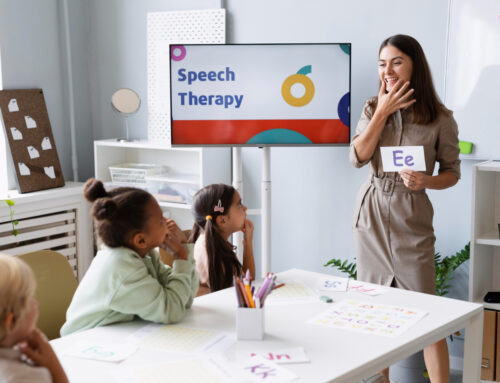
As a parent of a child who requires physical or occupational therapy visits in their home, do you ever wonder why therapists constantly have their hands on your child? This goes for children who are being seen for therapy due to some type of movement-related disorder or dysfunction (i.e., cerebral palsy, pediatric stroke muscular dystrophy, etc.). Do you ever wonder what details go into handling your child, or does it look like the therapist is providing the movement for them?
Physical handling, sometimes referred to manual handling or therapeutic handling, is exactly what is says: using hands-on contact with an individual in order to promote safe, functional movement within the environment. Physical handling is frequently used because visual and verbal cues aren’t enough to get a child going. Verbal cues include examples such as “Come over here”, “walk to the door”, “go grab your coat”, “Go get the toy”. Visual cues include pointing, flashcard or handwritten commands, nodding/shaking the head, etc. Here are some observable reasons why a child may not be able to move or complete a functional movement to perform daily tasks, even when provided verbal or visual commands:
- The child has complete or partial paralysis of one or more muscle groups.
- The child is in pain and is unable to verbally communicate the problem.
- The child is blind and/or deaf.
- The child has reduced cognition, which impedes his or her ability to comprehend visual or verbal cues.
- The child is in their infancy and has yet to understand visual or verbal cues to prompt movement.
Physical handling comes in many forms depending on what the therapist is trying to accomplish during intervention in order to meet the child’s goals. Examples may include:
- Stretching or ranging tightened muscle tissue from atrophy or lack of movement.
- Manual therapy in the form of massage or lymphatic drainage.
- Filling in missing components of movements that the child is not able to complete independently (i.e., neurodevelopmental treatment).
Confused yet? If you’re not a trained occupational or physical therapist, than most of these terms like “neurodevelopmental” and “lymphatic” aren’t going to make much sense…and that’s fine. Your job as a parent or a guardian is to find out where you fit into the intervention equation. Run yourself through these series of questions and openly communicate with your OT about how you are to carry out this intervention once the therapist leaves for the day.
- What are your child’s goals or your goals for your child? Do any of your goals have anything to do with getting your child to move better? Maybe your child is not meeting motor milestones on time (i.e., rolling, crawling, sitting, standing, walking) or can’t perform certain movements because of obvious muscle tightness or laxity. If your goals have anything to do with improving fine (hands) and gross (large muscle group) motor movement or coordination, then you might be expected to use physical handling techniques.
- What interventions does the OT plan on using? Have a very open discussion with the OT about what types of treatments they plan on introducing. Ask them any question you like before or while your child receives intervention. Furthermore, ask them if he/she plans on using any types of hands-on treatments in order to get your child to move better.
- If there is physical handling, what purpose does it serve? Once you find out if the OT plans on using physical handling techniques, openly ask them what it’s for. Such questions may include, “Why place or hands there instead of there?”, “What movements are you helping my child do and what are they doing on their own?”, “Are you stretching them, lifting them, massaging them?” From a bystander view, it can be difficult to visually distinguish what the therapist is doing with their hands, so please ask!
- If I’m guiding my child’s movements, what precautions should I be aware of? Before the therapist leaves, make sure you receive complete education about the do’s and don’ts of physically handling your child specifically. Ask about what movements to avoid, proper hand placement to minimize or eliminate painful movements, use of skilled movement in order to avoid injuring your child, etc.
- How often should I be physically handling my child? Each therapist will have an exercise and handling regiment tailored specifically to each child’s needs. Consult with your therapist about how often, as a parent, you are expected to use physical handling with your child and for what movements or activities.





